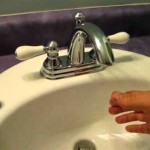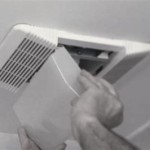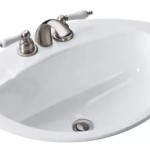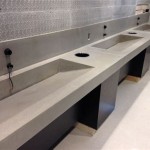How To Clean Your Bathroom Tile Floor
Bathroom tile floors, while aesthetically pleasing and generally durable, are susceptible to the accumulation of dirt, grime, soap scum, mildew, and hard water stains. Regular cleaning is essential not only for maintaining the visual appeal of the bathroom but also for preventing the growth of harmful bacteria and mold that thrive in moist environments. This article provides a comprehensive guide on effectively cleaning bathroom tile floors, covering preparation, cleaning solutions, application methods, and maintenance tips.
Preparation for Cleaning
Before commencing the actual cleaning process, several preparatory steps are crucial for ensuring optimal results and protecting both the tile floor and the surrounding bathroom fixtures. These steps involve gathering necessary supplies, pre-treating problem areas, and preparing the cleaning area.
Gathering Supplies: The following items are typically required for cleaning bathroom tile floors:
• A broom or vacuum cleaner: Used to remove loose debris and dirt before wet cleaning.
• A mop: A microfiber mop is recommended for its absorbent qualities and gentle cleaning action. Sponge mops can also be used, but they may not be as effective at removing dirt from grout lines.
• Two buckets: One for the cleaning solution and one for rinsing.
• A scrub brush: A stiff-bristled brush is useful for scrubbing grout lines and tackling stubborn stains.
• Cleaning solutions: The choice of cleaner depends on the type of tile and the severity of the grime. Options include:
• All-purpose cleaners: Suitable for general cleaning.
• Tile and grout cleaners: Specifically formulated to remove soap scum and mildew.
• White vinegar: A natural and effective solution for dissolving hard water stains and soap scum.
• Baking soda: A mild abrasive that can be used to scrub stubborn stains.
• Hydrogen peroxide: A disinfectant and stain remover that is particularly effective against mold and mildew.
• Protective gear: Gloves are recommended to protect hands from harsh chemicals. Eye protection may be necessary when using strong cleaners.
• Clean cloths or towels: For drying the floor after cleaning.
Pre-Treating Problem Areas: Specific stains and areas with heavy buildup may require pre-treatment to loosen the grime and facilitate easier cleaning.
• Soap Scum: Apply a solution of white vinegar and water (1:1 ratio) to the affected areas and let it sit for 10-15 minutes before scrubbing.
• Mold and Mildew: Spray a solution of hydrogen peroxide (3% concentration) or a mold and mildew remover onto the affected areas. Allow it to sit for 10-15 minutes before scrubbing. Ensure adequate ventilation when using mold and mildew removers.
• Hard Water Stains: Create a paste of baking soda and water and apply it to the stains. Let it sit for 15-20 minutes before scrubbing.
Preparing the Cleaning Area: Before beginning the cleaning process, remove all loose items from the bathroom floor, such as rugs, trash cans, and scales. This will provide unobstructed access to the entire floor surface. Additionally, ensure that the bathroom is well-ventilated by opening windows or turning on the exhaust fan.
Selecting and Applying Cleaning Solutions
The effectiveness of cleaning bathroom tile floors depends significantly on the selection of appropriate cleaning solutions and the proper application methods. Different types of tiles may require specific cleaning agents, and the severity of the grime and stains will also influence the choice of cleaner.
Choosing the Right Cleaning Solution:
• For general cleaning, an all-purpose cleaner diluted in water is usually sufficient. Follow the manufacturer's instructions for the correct dilution ratio.
• For more stubborn soap scum and hard water stains, a tile and grout cleaner or a solution of white vinegar and water is recommended. White vinegar is a natural and effective alternative to harsh chemicals.
• For mold and mildew, a dedicated mold and mildew remover or a solution of hydrogen peroxide is necessary. When using these products, always follow the manufacturer's safety precautions and ensure adequate ventilation.
Applying the Cleaning Solution:
• After selecting the appropriate cleaning solution, pour it into the first bucket. Fill the second bucket with clean water for rinsing.
• Dip the mop into the cleaning solution, wring out excess liquid, and apply the solution to the tile floor in sections. Avoid oversaturating the floor, as this can lead to water damage and prolonged drying times.
• Allow the cleaning solution to sit on the floor for a few minutes to loosen the dirt and grime. This dwell time will vary depending on the severity of the buildup and the type of cleaner used.
• Using a scrub brush, pay particular attention to the grout lines, which tend to accumulate dirt and mildew. Scrub the grout lines with the brush in a back-and-forth motion to dislodge the grime. For wider grout lines, a grout brush with a pointed tip may be more effective.
• Once the entire floor has been scrubbed, use the mop to remove the dirty cleaning solution. Rinse the mop frequently in the clean water bucket to avoid spreading the dirt back onto the floor.
Rinsing and Drying:
• After removing the dirty cleaning solution, thoroughly rinse the floor with clean water. Use the mop to apply clean water to the floor and then wring it out to remove the water and any remaining residue. Repeat this process until the floor is free of any visible traces of the cleaning solution.
• Once the floor has been rinsed, dry it with clean cloths or towels. This will prevent water spots and streaking. Alternatively, you can allow the floor to air dry, but it is important to ensure that the bathroom is well-ventilated to facilitate faster drying.
Maintaining Your Clean Tile Floor
Maintaining a clean bathroom tile floor requires consistent effort and adherence to a regular cleaning schedule. By implementing preventative measures and following proper cleaning practices, you can prolong the life of your tile floor and keep it looking its best.
Regular Cleaning Schedule:
• Sweep or vacuum the bathroom floor at least once a week to remove loose dirt and debris. This will prevent the buildup of grime and make the cleaning process easier.
• Mop the floor with a mild cleaning solution every one to two weeks, depending on the level of traffic and usage. This will help remove soap scum and hard water stains before they become difficult to remove.
• Deep clean the grout lines every few months using a scrub brush and a grout cleaner. This will prevent the growth of mold and mildew and keep the grout lines looking clean and bright.
Preventative Measures:
• Use a squeegee to wipe down the shower walls and floor after each use. This will remove excess water and prevent the buildup of soap scum and hard water stains.
• Place mats or rugs in front of the shower and sink to absorb excess water and prevent slips and falls. Be sure to wash or dry these mats regularly to prevent the growth of mold and mildew.
• Ensure that the bathroom is well-ventilated by opening windows or turning on the exhaust fan after each use. This will help to dry the floor and prevent the growth of mold and mildew.
• Avoid using harsh chemicals or abrasive cleaners on the tile floor. These can damage the tile and grout and make them more susceptible to staining.
• Clean up spills immediately to prevent staining. Use a clean cloth or towel to blot the spill and then clean the area with a mild cleaning solution.
Addressing Stubborn Stains:
• For stubborn stains, such as rust or ink, try using a specialized stain remover. Follow the manufacturer's instructions carefully and test the cleaner on an inconspicuous area of the floor before applying it to the entire stain.
• For organic stains, such as coffee or tea, try using a paste of baking soda and water. Apply the paste to the stain, let it sit for 15-20 minutes, and then scrub with a soft brush.
• For greasy stains, try using a degreasing cleaner or a solution of dish soap and water. Apply the cleaner to the stain, let it sit for a few minutes, and then scrub with a soft brush.
By following these guidelines, one can effectively clean and maintain bathroom tile floors, ensuring a hygienic and aesthetically pleasing bathroom environment.

Tips And S About Deep Cleaning Your Bathroom Tiles Certified Clean Care

How To Clean Your Bathroom Tiles Stone Deals

How To Clean Bathroom Tiles With Baking Soda Mygate

How To Deep Clean A Tile Floor Maid Sailors

Spring Clean How To Tiles Correctly Tile Mountain

How To Wash Your Bathroom Floor 13 Steps With Pictures

How To Clean Ceramic Tile Floors

How To Clean Floor Tile Grout In The Bathroom Clorox

How To Clean Porcelain Tile Everything You Need Know Rubi Blog Usa

How To Clean Grout In Your Shower Alpine Carpet Cleaning
Related Posts







